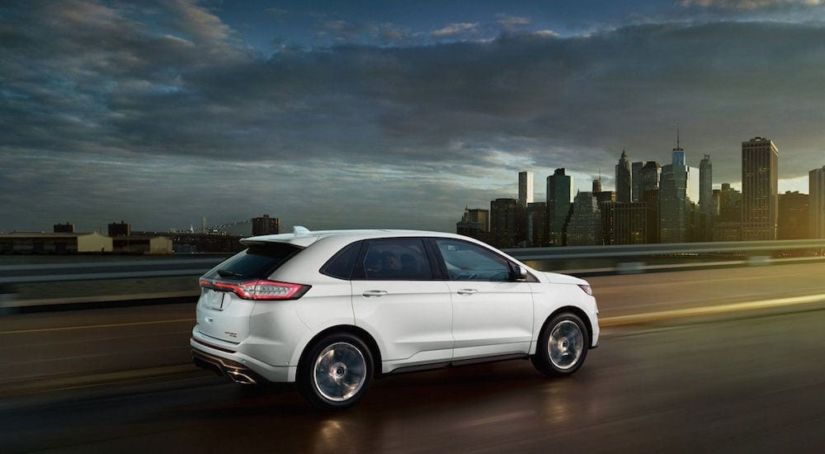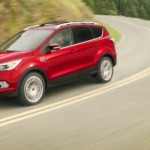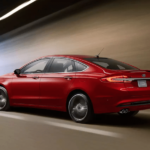At first glance, there wasn’t much about the Ford Edge that grabbed my attention or yanked me around to take a closer look. In all fairness, that’s not really a criticism of the Edge itself, but more so of what the over-saturated crossover / SUV marketplace has become. Varying levels of “boxy” designs, contoured to give off a sportier feel, have devolved smart vehicle designs into the minivans of tomorrow. The indictment isn’t specific to any model in particular, as it certainly permeates the class. With that in mind, how successful is the Ford Edge at avoiding its own devolution into some sort of next-generation Aerostar?
The answer is: extremely successful. While a quick glance might have left a lackluster first impression, the Edge will not disappoint those who take the time to dig a little bit deeper.
The Basics
Starting at $28,950 MSRP, the Ford Edge is available in four different trim levels: the SE, SEL, Titanium, and Sport. If you’re looking to set a low-high breakdown of the trim pricing, the Sport is priced at $40,400 to start. While the respective trims may not offer much differentiation in terms of exterior design, there is certainly a marked ascension of features worth exploring. Across the board, the Edge is compelling and delivers strong value for the dollar.
That said, any vehicle should be compared to its competing stablemates. Any consideration of the Ford Focus should come be accompanied by a look at the Nissan Murano, the Jeep Grand Cherokee, and the GMC Acadia. Rest assured though, the Edge can hold its own.
Exterior Design
As mentioned above, any lack of innovation shown in the exterior design isn’t a knock against the Edge itself. If you disregard the inherent design trappings of crossover SUVs, the Edge actually has some nice design notes that break the mold of traditional Ford body styling.
Recently, I’d criticized the Ford Focus for sacrificing the momentum of a strong front-end design with a bland body and profile. The Edge sidesteps that pitfall entirely. With a tapered contouring across the door panels, the Edge avoids appearing “boxy” (or appearing to overcompensate in the hopes of “not looking boxy”). Score one for the Edge, as Ford designers should certainly take a cue and re-evaluate some of their other designs.
Performance
The Edge offers up three different engine configurations. The turbocharged 2.0-liter four-cylinder (standard on all trims, except the Sport) delivers 245 horsepower and 275 lbs-ft of torque. Available in either Front or All-Wheel Drive, this engine (pared with a six-speed automatic transmission) averages an estimated 23-24 mpg (combined).
Buyers who opt for the SEL and Titanium trims, can choose the 3.5-liter V6, generating 280 horsepower and 250 lbs-ft. Averaging 20 mpg, this non-turbocharged option mirrors the 2.0-liter’s ability to tow up to 3,500 LBS when properly equipped.
With the top-of-the-line AWD Sport trim, a turbocharged 2.7-liter V6 delivers an impressive 315 horsepower and 350 lbs-ft. Considering the jump in output, it’s impressive to think that its fuel-economy is on par with the base-level 2.0-liter four cylinder. The only downside is a decrease in towing capacity, as the Sport is rated for 2,000 LBS.
All in all, the Edge offers a nice range of options for enhancing the overall driving experience. While the standard 2.0 four-cylinder may be plenty for most drivers, you can’t argue the appeal of the V6, especially when you can expect comparable fuel efficiency.
Interior Design
The Edge boasts a spacious cab design, providing ample room for five adults. Considering the tendency of two-row subcompact crossovers to sacrifice comfort, the Edge provides a happy medium between such ill-fitting choices and the next step of oversized three-row SUVs. That said, we’d be doing the Edge a disservice if we didn’t specify that the rear seating actually accommodates three adults comfortably.
And with a nice selection of quality materials, the interior of the Edge is genuinely welcoming. A simplicity of design emanates from the central screen, creating an open and clean feel throughout the gauge cluster and controls. Years ago, this might have given the impression of lacking design; but in response to the more recent prominence of control features, it is refreshing. As a result, the cabin conveys a sense of openness.
The interior is further enhanced at the SEL trim level, receiving leather upholstery and ambient lighting. That said, this is just an embellishment on a cabin that is already well-designed for both drivers and passengers alike.
Available Technology
Despite the clarity of design, the Edge has no shortage of tech amenities available across the various trim levels. The (base) SE model comes with everything you’d expect: a 4.2-inch central display, six-speaker sound system with CD and USB ports, Bluetooth phone and audio capability and Ford’s sync system (with voice recognition).
The SEL trim features a few upgrades including satellite radio, nine-speaker sound system, and 8-inch touchscreen. An added feature worthy of note is the placement of two screens (within the instrument cluster) that can be configured based on the driver’s preference. Step up to the Titanium trim, and the stereo boosts to a 12-speaker Sony system with HD radio.
Regardless of which Edge trim you choose, a rear entertainment system is optional. Considering the spacious accommodations for rear-seated passengers, this option becomes a valuable enhancement (as opposed to a consolation for, or distraction away from, a less comfortable ride).
Closing Thoughts
In more ways than those listed here, the Ford Edge is a success. With a design that is on-brand, it manages to stand out among Fords and competitors alike. Delivering powertrain options and nicely-tiered trim levels, it lends itself to customization and the cabin design shows forethought and innovation. Well-worth the consideration, the Ford Edge might (dare I say) ‘edge’ out its rivals.



